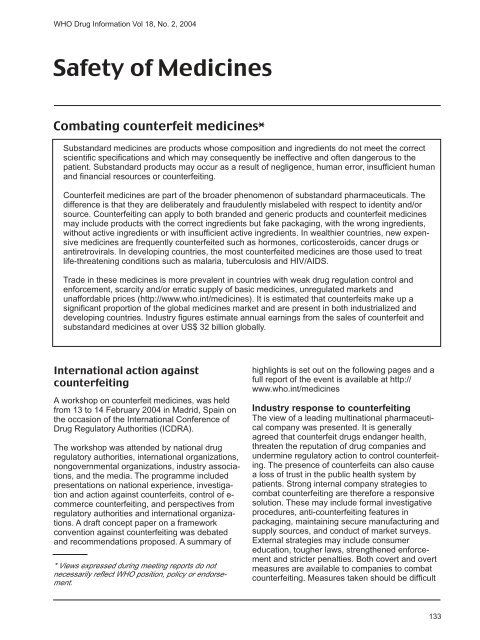WHO Drug Information Vol. 18, No. 2, 2004 - World Health ...
WHO Drug Information Vol. 18, No. 2, 2004 - World Health ...
WHO Drug Information Vol. 18, No. 2, 2004 - World Health ...
You also want an ePaper? Increase the reach of your titles
YUMPU automatically turns print PDFs into web optimized ePapers that Google loves.
<strong>WHO</strong> <strong>Drug</strong> <strong>Information</strong> <strong>Vol</strong> <strong>18</strong>, <strong>No</strong>. 2, <strong>2004</strong><br />
Safety of Medicines<br />
Combating counterfeit medicines*<br />
Substandard medicines are products whose composition and ingredients do not meet the correct<br />
scientific specifications and which may consequently be ineffective and often dangerous to the<br />
patient. Substandard products may occur as a result of negligence, human error, insufficient human<br />
and financial resources or counterfeiting.<br />
Counterfeit medicines are part of the broader phenomenon of substandard pharmaceuticals. The<br />
difference is that they are deliberately and fraudulently mislabeled with respect to identity and/or<br />
source. Counterfeiting can apply to both branded and generic products and counterfeit medicines<br />
may include products with the correct ingredients but fake packaging, with the wrong ingredients,<br />
without active ingredients or with insufficient active ingredients. In wealthier countries, new expensive<br />
medicines are frequently counterfeited such as hormones, corticosteroids, cancer drugs or<br />
antiretrovirals. In developing countries, the most counterfeited medicines are those used to treat<br />
life-threatening conditions such as malaria, tuberculosis and HIV/AIDS.<br />
Trade in these medicines is more prevalent in countries with weak drug regulation control and<br />
enforcement, scarcity and/or erratic supply of basic medicines, unregulated markets and<br />
unaffordable prices (http://www.who.int/medicines). It is estimated that counterfeits make up a<br />
significant proportion of the global medicines market and are present in both industrialized and<br />
developing countries. Industry figures estimate annual earnings from the sales of counterfeit and<br />
substandard medicines at over US$ 32 billion globally.<br />
International action against<br />
counterfeiting<br />
A workshop on counterfeit medicines, was held<br />
from 13 to 14 February <strong>2004</strong> in Madrid, Spain on<br />
the occasion of the International Conference of<br />
<strong>Drug</strong> Regulatory Authorities (ICDRA).<br />
The workshop was attended by national drug<br />
regulatory authorities, international organizations,<br />
nongovernmental organizations, industry associations,<br />
and the media. The programme included<br />
presentations on national experience, investigation<br />
and action against counterfeits, control of ecommerce<br />
counterfeiting, and perspectives from<br />
regulatory authorities and international organizations.<br />
A draft concept paper on a framework<br />
convention against counterfeiting was debated<br />
and recommendations proposed. A summary of<br />
* Views expressed during meeting reports do not<br />
necessarily reflect <strong>WHO</strong> position, policy or endorsement.<br />
highlights is set out on the following pages and a<br />
full report of the event is available at http://<br />
www.who.int/medicines<br />
Industry response to counterfeiting<br />
The view of a leading multinational pharmaceutical<br />
company was presented. It is generally<br />
agreed that counterfeit drugs endanger health,<br />
threaten the reputation of drug companies and<br />
undermine regulatory action to control counterfeiting.<br />
The presence of counterfeits can also cause<br />
a loss of trust in the public health system by<br />
patients. Strong internal company strategies to<br />
combat counterfeiting are therefore a responsive<br />
solution. These may include formal investigative<br />
procedures, anti-counterfeiting features in<br />
packaging, maintaining secure manufacturing and<br />
supply sources, and conduct of market surveys.<br />
External strategies may include consumer<br />
education, tougher laws, strengthened enforcement<br />
and stricter penalties. Both covert and overt<br />
measures are available to companies to combat<br />
counterfeiting. Measures taken should be difficult<br />
133

















